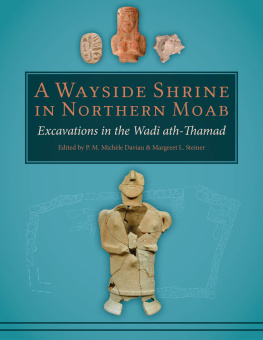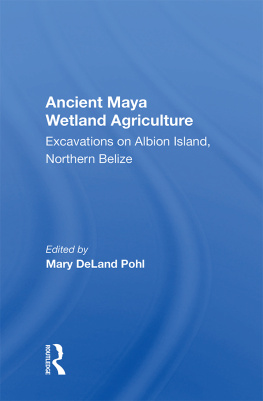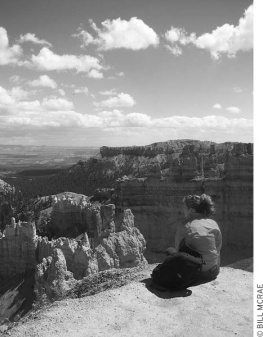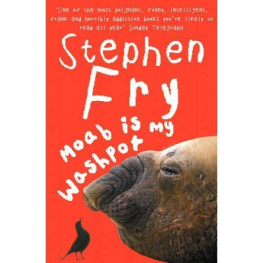

Published in the United Kingdom in 2017 by
OXBOW BOOKS
The Old Music Hall, 106108 Cowley Road, Oxford OX4 1JE
and in the United States by
OXBOW BOOKS
1950 Lawrence Road, Havertown, PA 19083
Oxbow Books and the individual authors 2017
Hardback Edition: ISBN 978-1-78570-708-7 (hardback)
Digital Edition: ISBN 978-1-78570-709-4 (epub)
A CIP record for this book is available from the British Library and the Library of Congress
All rights reserved. No part of this book may be reproduced or transmitted in any form or by any means, electronic or mechanical including photocopying, recording or by any information storage and retrieval system, without permission from the publisher in writing.
Printed in Malta by Melita Press Ltd
Typeset in India by Lapiz Digital Services, Chennai
For a complete list of Oxbow titles, please contact:
UNITED KINGDOM
Oxbow Books
Telephone (01865) 241249, Fax (01865) 794449
Email:
www.oxbowbooks.com
UNITED STATES OF AMERICA
Oxbow Books
Telephone (800) 791-9354, Fax (610) 853-9146
Email:
www.casemateacademic.com/oxbow
Oxbow Books is part of the Casemate Group
Front cover: Photos of assorted artefacts from the site courtesy of Dr B. A. Haberstroh, M.D.
Contents
P. M. Michle Daviau with an excursus by Carlos E. Cordova
P. M. Michle Daviau
P. M. Michle Daviau
P. M. Michle Daviau
P. M. Michle Daviau
Margreet L. Steiner
P. M. Michle Daviau
Jan Gunneweg and Marta Balla
David Lipovitch
David S. Reese
Kenneth J. McNamara
P. M. Michle Daviau and Gabrielle Cole
P. M. Michle Daviau with an Excursus by Robert M. Kerr
Christopher M. Foley with contributions by P. M. Michle Daviau
P. M. Michle Daviau
www resources: https://downloads.wlu.ca/WadiThamad
Databases
Field Images
Pottery
Artefacts
Beads
List of tables and charts
Tables
Charts
List of illustrations
.
.
.
.
Preface
The excavations at orvat Qimit, Kuntillet  Ajrud, and
Ajrud, and  En aeva opened a new window on the complexity of Iron Age society and religion in southern Palestine, a region where both Judeans and Edomites lived. At the same time, it is not clear whether the religious practices attested at these southern sites were a reflection of localized customs or were common rituals for Judean and Edomite communities. What is clear is that the evidence from archaeological excavations expands our understanding of religious beliefs and cultic activities, some of which are not reflected in either the Biblical text or other contemporary textual sources. At present, we do not know the extent of these practices, whether they were also known in other areas of the region, especially in the small kingdoms of Transjordan, such as the heartland of Edom itself or, to the north, in Moab and Ammon.
En aeva opened a new window on the complexity of Iron Age society and religion in southern Palestine, a region where both Judeans and Edomites lived. At the same time, it is not clear whether the religious practices attested at these southern sites were a reflection of localized customs or were common rituals for Judean and Edomite communities. What is clear is that the evidence from archaeological excavations expands our understanding of religious beliefs and cultic activities, some of which are not reflected in either the Biblical text or other contemporary textual sources. At present, we do not know the extent of these practices, whether they were also known in other areas of the region, especially in the small kingdoms of Transjordan, such as the heartland of Edom itself or, to the north, in Moab and Ammon.
The discovery of an isolated shrine site in northern Moab which contained Iron Age figurines and statues may contribute to our understanding of the distribution of wayside shrines and their cultic practices, if not of the deities known to the worshipers. The finds at Wadi ath-Thamad Site WT-13 (henceforth, WT-13) are numerous and remain a challenge to excavators and interpreters alike. In order to do justice to this discovery, several scholars contributed to the excavation, analysis, and publication of this site and its remains.
A salvage excavation was undertaken in 1997 by the Wadi ath-Thamad Project thanks to the encouragement of Dr. Ghazi Bisheh, then Director General of Antiquities, and with the support of the Department of Antiquities of Jordan. Housing for the team during the first three seasons was at ACOR in  Amman, where we gratefully received the enthusiastic support of the Director, Dr. Pierre Bikai, and of the staff. In 1999, Mrs. Nelly Lama facilitated arrangements with Lylys Pension Hotel in Madaba, where the team lived during the 1999, 2001 and 2003 seasons. Partial funding was provided by a grant from ASORs Committee on Archaeological Policy Grants sub-committee, as well as by a Short Term grant from Wilfrid Laurier University, funded in part by the WLU Research Budget and in part by the SSHRC General Research Grant awarded to WLU. Two excavation seasons (2001, 2003) and the subsequent study of the artefacts, samples and figurines were funded by a three year Standard Research Grant from the Social Sciences and Humanities Research Council of Canada (SSHRC).
Amman, where we gratefully received the enthusiastic support of the Director, Dr. Pierre Bikai, and of the staff. In 1999, Mrs. Nelly Lama facilitated arrangements with Lylys Pension Hotel in Madaba, where the team lived during the 1999, 2001 and 2003 seasons. Partial funding was provided by a grant from ASORs Committee on Archaeological Policy Grants sub-committee, as well as by a Short Term grant from Wilfrid Laurier University, funded in part by the WLU Research Budget and in part by the SSHRC General Research Grant awarded to WLU. Two excavation seasons (2001, 2003) and the subsequent study of the artefacts, samples and figurines were funded by a three year Standard Research Grant from the Social Sciences and Humanities Research Council of Canada (SSHRC).
Team members (Pl. A) and scholars whose interest in this site made a significant contribution to our research include Romeo Levesque, who set up the initial grid of the site and excavated with care and enthusiasm in the initial season (1997); Carlos Cordova, who studied the geomorphology of the wadi system; Jan Gunneweg, whose generous initiative resulted in INAA processing of fragments of WT-13 figurines, statues and pottery at the Institute of Nuclear Techniques, Budapest University of Technology and Economics, in order to compare their ceramic chemistry with that of statues from orvat Qimit and  En aeva; Annlee Dolan, who undertook an initial study of WT-13 in the context of Moabite religion (unpublished Ph. D. dissertation, 2007); Margreet Steiner who studied the diagnostic sherds and contributed to an analysis of the fabric composition, undertaken by Loe Jacobs at the Laboratory for Ceramic Studies of Leiden University; David Reese, who studied the shells and Kenneth McNamara who prepared a report on fossil sea urchins; David Lipovitch who analyzed the faunal remains; Robert M. Kerr, who interpreted a Thamudic inscription; and B. Conant and Jason Venkiteswaran, geologists at Wilfrid Laurier University who identified exotic stone samples. Additional data, detailed locus information, databases and illustrations are available at https://downloads.wlu.ca/WadiThamad.
En aeva; Annlee Dolan, who undertook an initial study of WT-13 in the context of Moabite religion (unpublished Ph. D. dissertation, 2007); Margreet Steiner who studied the diagnostic sherds and contributed to an analysis of the fabric composition, undertaken by Loe Jacobs at the Laboratory for Ceramic Studies of Leiden University; David Reese, who studied the shells and Kenneth McNamara who prepared a report on fossil sea urchins; David Lipovitch who analyzed the faunal remains; Robert M. Kerr, who interpreted a Thamudic inscription; and B. Conant and Jason Venkiteswaran, geologists at Wilfrid Laurier University who identified exotic stone samples. Additional data, detailed locus information, databases and illustrations are available at https://downloads.wlu.ca/WadiThamad.
Special thanks are due to those students and volunteers who washed and sorted thousands of ceramic sherds, especially Michael Berry, Christina Craig-Paul (now, Gohm), Melodee Degenais, Joyce Palmer, and Shannon Rozon; to Chelsea Hyde and Neil Sandison, co-op students, and Melissa Pritchard Beals, who entered details into the database; to Tiffany Mertsis, a Wilfrid Laurier work study student who drew diagnostic sherds previously sent to Leiden for analysis; to Helen Himmelman who carefully sorted, drew and entered into the database hundreds of diagnostic sherds curated at Wilfrid Laurier University; and to Marianne Kraft who identified and entered Munsell colour codes and proofread the text, along with Dr Laird Christie; to those who drew figurines and objects, namely Victor Bush, Benjamin Holthof, Tracy Scott, Robert Vingerhoets, Julie Witmer, and a special thanks to Heidi Wilson, who drew the statues; to the pottery and object registrars and to the photographers, Col. Robert Mittelstaedt and Dr. Bernard A. Haberstroh, M.D., who took photographs of objects and of the surrounding area with the survey team. Student square supervisors and volunteers excavated the severely disturbed remains with patience and care, yielding a harvest of finds from several phases of use, under the direction of Field Supervisor Laura Foley, who assisted the Director at WT-13. Special thanks also to Tracy Scott who participated in the formulation of the typology and classification of small fragments of figurines and statues; to Paul Bailey and Heidi Wilson, who scanned the artefact drawings; and to B. A. Haberstroh and E. Kate Johnston, who scanned the photographs and prepared the field images database for the WT-13 archive. For the good spirits and dedication of all of these workers and many more, the project director is extremely grateful.
Next page










 Ajrud, and
Ajrud, and